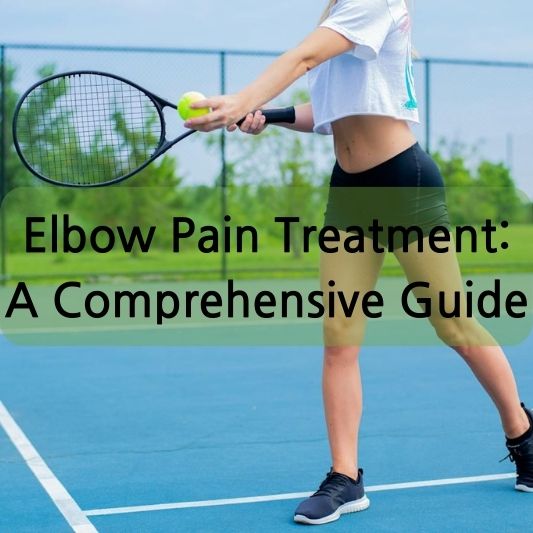Elbow pain can be a debilitating condition affecting individuals across various age groups and professions. From athletes to office workers, this discomfort can interfere with daily activities and significantly impact one’s quality of life. In this comprehensive guide, we’ll explore the causes, symptoms, diagnosis, and various treatment options for elbow pain.

I. Introduction
A. Definition of Elbow Pain
Elbow pain refers to the discomfort experienced in the elbow joint, often stemming from various underlying conditions.
B. Common Causes
Understanding the common causes of elbow pain is crucial for effective treatment. From overuse injuries to medical conditions, a range of factors can contribute to this issue.
II. Types of Elbow Pain
A. Tennis Elbow
Tennis elbow, or lateral epicondylitis, is a prevalent condition characterized by inflammation of the tendons on the outer side of the elbow.
B. Golfer’s Elbow
Golfer’s elbow, or medial epicondylitis, affects the inner tendons of the elbow and is commonly associated with repetitive gripping or throwing motions.
C. Cubital Tunnel Syndrome
This condition involves pressure or stretching of the ulnar nerve, leading to pain and numbness in the elbow.
III. Symptoms
A. Pain Characteristics
Elbow pain can manifest as a sharp, shooting pain or a dull ache, depending on the underlying cause.
B. Swelling and Stiffness
Accompanying symptoms may include swelling and stiffness, further complicating daily activities.
IV. Diagnosis
A. Medical History
A thorough understanding of the patient’s medical history helps in identifying potential causes and triggers.
B. Physical Examination
Physical examinations, including specific tests for each type of elbow pain, aid in accurate diagnosis.
C. Imaging Tests
X-rays, MRI, or ultrasound may be employed to visualize the internal structures and identify any abnormalities.
V. Conservative Treatments
A. Rest and Ice
Initial treatment often involves rest, ice application, and avoiding activities that exacerbate the pain.
B. Physical Therapy
Physical therapy exercises and techniques can strengthen the muscles and promote healing.
C. Medications
Over-the-counter pain relievers and anti-inflammatory medications may be recommended for managing pain and reducing inflammation.
VI. Advanced Treatments
A. Injections
Corticosteroid injections can provide relief by reducing inflammation and alleviating pain.
B. Extracorporeal Shock Wave Therapy
This non-invasive procedure uses shock waves to stimulate healing and reduce pain.
C. Surgery
In severe cases, surgical intervention may be necessary to repair damaged tendons or nerves.
VII. Home Remedies
A. Exercises
Specific exercises targeting the elbow joint can aid in recovery and prevent future injuries.
B. Proper Ergonomics
Maintaining proper ergonomics at work and during daily activities is crucial for preventing recurrent elbow pain.
C. Lifestyle Changes
Making lifestyle changes, such as incorporating regular breaks and stretching, can contribute to overall joint health.
VIII. Prevention
A. Warm-Up Exercises
Engaging in appropriate warm-up exercises before physical activities helps prepare the muscles and reduce the risk of injuries.
B. Protective Gear
Wearing appropriate protective gear, especially for athletes, can prevent direct impact and reduce the risk of injury.
C. Workstation Ergonomics
Ensuring a well-designed workstation can minimize strain on the elbows for office workers.
IX. Living with Elbow Pain
A. Coping Strategies
Implementing coping strategies, such as mindfulness and relaxation techniques, can help manage pain on a daily basis.
B. Emotional Impact
Acknowledging the emotional impact of chronic pain is crucial, and seeking support is encouraged.
X. When to Seek Medical Attention
A. Persistent Symptoms
If symptoms persist or worsen despite conservative measures, seeking medical attention is essential for a thorough evaluation.
B. Signs of Infection
Redness, swelling, and warmth may indicate an infection, requiring prompt medical intervention.
XI. Alternative Therapies
A. Acupuncture
Some individuals find relief through acupuncture, a traditional Chinese medicine technique involving the insertion of thin needles.
B. Chiropractic Care
Chiropractic adjustments may help alleviate elbow pain by addressing musculoskeletal imbalances.
C. Herbal Remedies
Certain herbal remedies, such as arnica or turmeric, are believed to have anti-inflammatory properties.
XII. Elbow Pain in Specific Professions
A. Athletes
Athletes may face unique challenges and treatment approaches tailored to their specific sports and activities.
B. Office Workers
Addressing the ergonomic needs of office workers is crucial in preventing and managing elbow pain.
C. Manual Laborers
Individuals engaged in manual labor may need specialized interventions considering the physical demands of their work.
XIII. Importance of Timely Treatment
A. Preventing Chronic Conditions
Timely treatment can prevent the progression of acute conditions into chronic, more complex issues.
B. Enhancing Quality of Life
Effective management of elbow pain enhances overall well-being and ensures a better quality of life.
XIV. Conclusion
A. Recap of Key Points
Understanding the causes, symptoms, and treatment options empowers individuals to take proactive steps in managing elbow pain.
B. Encouragement for Seeking
Help Encourage readers to seek professional help if they are experiencing persistent or worsening symptoms.
FAQs
Is elbow pain always a result of overuse?
Not necessarily. While overuse is a common cause, elbow pain can also stem from injuries, medical conditions, or other factors.
Are surgical interventions the only solution for severe elbow pain?
Surgery is considered in severe cases, but many individuals find relief through conservative treatments and lifestyle changes.
Can office workers prevent elbow pain through ergonomic adjustments?
Yes, maintaining proper workstation ergonomics and taking regular breaks can significantly reduce the risk of elbow pain for office workers.
How long does it take for conservative treatments to show results?
The timeline varies, but many individuals experience relief within a few weeks of following conservative treatments.
Is there a connection between emotional well-being and elbow pain?
Yes, chronic pain can impact emotional well-being. Implementing coping strategies and seeking support is crucial for overall health.
Find out the price of nutritional supplements to help with joint health on iHerb!
